Among the 7 UNESCO listed world heritage sites in Kathmandu Valley, Swayambhunath is one of Nepal's most ancient religious complexes and a prominent landmark. Often referred to as the "Monkey Temple" due to the large population of monkeys that inhabit the area, it is one of the oldest religious sites in Nepal, with its origins tracing back to approximately the 5th century CE. This blog, Swayambhunath Stupa, aims to acknowledge the historical, cultural, and religious significance of the site and assist you in making your exploration easy.
Swayambhunath itself translates to self existence hinting at the site's legendary origins and its lasting importance as a sacred pilgrimage destination for both Buddhists and Hindus. It has stood as a hallmark of faith and harmony for centuries, with Hindu temples and deities incorporated into this Buddhist site. This calm yet chaotic premise houses various temples, monuments, and shrines that are significant both culturally and religiously. Different highlights of Swayambhunath boast about the ancient Nepalese architecture, its religious importance, dedicated festivals, and history within it. The attractions include the mighty Harati temple, the ritual instrument Vajra, the historic Dewa Dharma Monastery, the holy World Peace Pond, and many other hidden gems.
Swyambhunath isn’t just a stunning religious monument. It's also one of the best viewpoints in the Kathmandu Valley. It overlooks most of the city, giving a panoramic view of the city. The climb up the 365 steps is a physical ascent, but it also leads to a powerful sense of spiritual awakening fostered by the site's tranquil yet potent atmosphere. The site's historical and cultural significance, coupled with its spiritual ambience and panoramic views of Kathmandu, make Swayambhunath a profound testament to Nepal's rich religious heritage.
Also Read: Lumbini of Nepal
Swayambhunath Stupa Facts
|
Heritage Site |
Swaymabhunath Stupa |
|
Affiliation |
Buddhism, Hinduism |
|
Location |
Swayambhu, Kathmandu |
|
Established in |
460 AD, 3rd Century (believed) |
|
UNESCO listed |
1979 AD |
|
Major Attractions |
|
|
Major Celebrations |
|
|
Architectural Style |
|
|
Opening Hours |
Open 24 hours |
|
Entry Fees |
Free for Nepalese and children below 10 years |
Origin and History
Its establishment is steeped in mythical lore and historical evolution, often linked to the legends of Manjushree, a bodhisattva in Mahayana Buddhism. Legend tells of a vast lake where a lotus seed, blessed by an ancient Buddha, bloomed into a radiant, self-existent light. Manjushree, a revered Buddhist figure, divided a passage through Chovar to drain the lake, revealing the Kathmandu Valley. His aim was to make that revered site accessible to everyone, including the common people. As the water was completely drained, the bloomed lotus then became a hill, and the luminous entity is said to have transformed into the Swayambhu stupa we see today. Later, it was enclosed in a protective structure by King Prachandadev, becoming a sacred pilgrimage site for both Buddhists and Hindus.
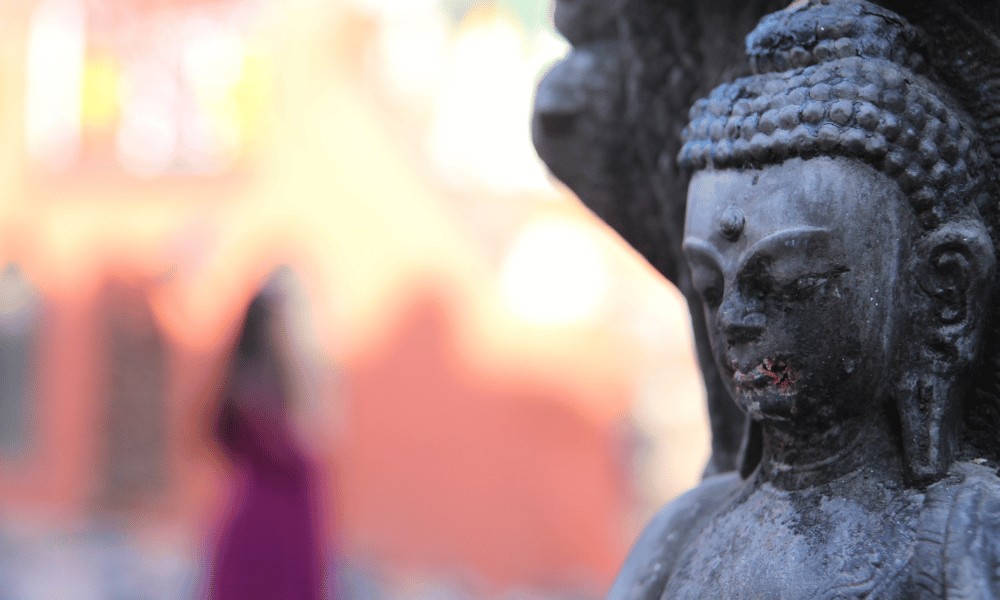
Historically, Swayambhunath has stood as a testament to the synthesis of Hindu and Buddhist spiritual practices prevalent in Nepal. While the exact date remains unclear, archaeological evidence suggests the site held religious significance as early as the 3rd century BCE. Emperor Ashoka, a famous Buddhist ruler, is said to have visited and possibly built a structure there. More concrete evidence points to its establishment in the 5th century CE, which is backed by the Gopalarajavamsavali, a chronicle of Nepal's rulers, mentioning that King Vrsadeva established the stupa around this time. A damaged stone inscription found at the site further supports this, indicating work done during Vrsadeva’s grandson King Manadeva's reign in the 7th century CE.
During a Muslim invasion in the 14th century, many historical and religious sites were destroyed, causing some damage to the stupa as well. After 23 years of this incident, a nobleman named Rajharsh Bhallock of Kathmandu city renovated this stupa. Despite the fact that the stupa has undergone several renovations and repairs over time due to its cultural and historical significance, the site was declared one of the UNESCO listed world heritage sites of Kathmandu Valley in 1979 AD. Additionally, the devastating earthquake of 2015 had an impact on some of the sites within the building. However, almost all the sites affected have been restored already. Today, Swayambhunath Stupa remains a prominent landmark and a vibrant centre of pilgrimage, attracting visitors from all faiths and backgrounds.
Local Significance
Beyond its status as a UNESCO World Heritage Site, Swayambhunath Stupa holds deep significance for the people of Kathmandu. Towering over the city, it is seen as a guardian of the Kathmandu Valley. Locals believe its presence ensures peace and stability. This belief fosters a sense of security and reverence among the residents.

For generations, it has had immense local significance, both culturally and spiritually, for the Newar community, the indigenous people of the Kathmandu Valley, and for the wider Nepalese populace, including both Buddhists and Hindus. Undertaking pilgrimage to Swayambhnath is taken as a sense of piety, bringing blessings and spiritual merit. This tradition strengthens the religious identity of the local community. Despite the presence of distinct faiths, it is believed to foster a sense of unity among the locals. Also, it serves as a focal point for many Buddhist festivals celebrated by different ethnic groups in Nepal. From the daily rituals to the vibrant festivals, Swayambhunath serves as a platform for cultural exchange and reinforces the importance of traditions for the community of Kathmandu.
Religious and Cultural Significance
Swayambhunath stands as a powerful symbol of Nepal's unique cultural and religious blend. Revered by both Hindus and Buddhists, it transcends religious boundaries. Hindus view it as a manifestation of a primordial Buddha, while Buddhists see it as a representation of enlightenment. This shared reverence reflects the harmonious coexistence of these two faiths in Nepal. Its origins are shrouded in legend, but its historical significance is undeniable, with its stupa structure dating back centuries. Every element of Swayambhunath is symbolic, from the dome representing enlightenment to the all seeing eyes reflecting Buddha's omniscience. Witnessing the various religious practices here is captivating. Devotees of both faiths are seen here spinning prayer wheels, chanting mantras, and lighting incense, while Hindu pilgrims pay homage to shrines and Buddhist monks add a serene presence.
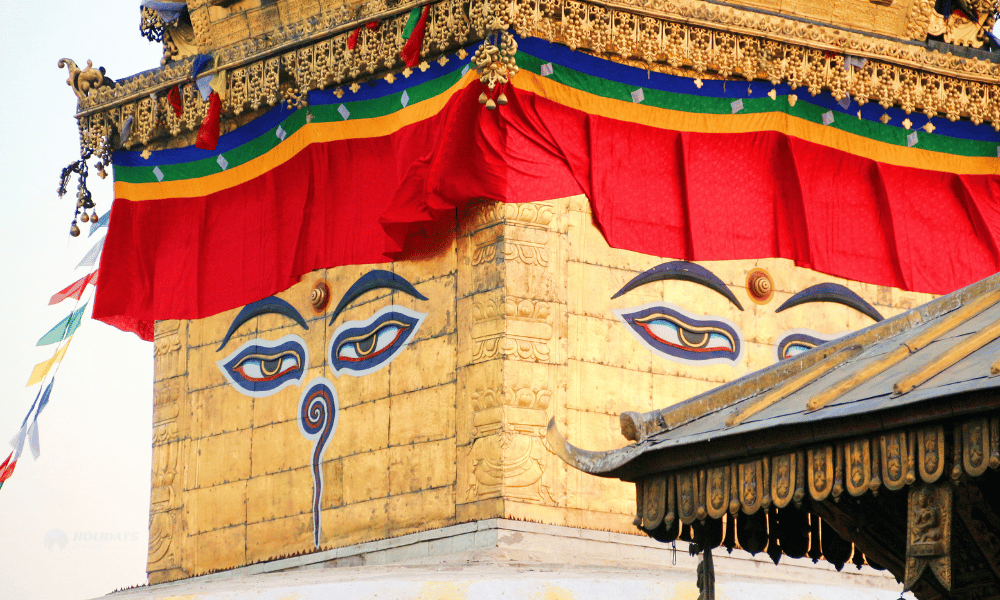
Besides that, it is more than a religious site; it's a vibrant hub where culture, history, and spirituality intertwine, fostering peace and a deep respect for Nepal's rich religious heritage. Housing significant cultural temples and shrines such as Harati Temple, Prattapur and Anantapur temples, and Dewa Dharma Monastery, this UNESCO listed world heritage site draws visitors from around the world who come to admire its beauty and to understand its cultural and spiritual contexts. Additionally, it serves as an educational site, not just in religious terms but also helping to promote understanding of Nepalese culture, history, and spirituality.
Architecture and Symbolism
In terms of architecture, the Swayambhunath stupa looks the same from every side, as it displays a combination of three plutonic shapes, the hemisphere, the cuboid, and the pyramid. The structure is divided into a drum, a dome, and a finial. The drum is the lowest element of the structure; the dome is the most important part of the structure, as it is believed to hold ancient relics and also contains a central mast; and the finial is composed of a cube, pyramid, and pinnacle.
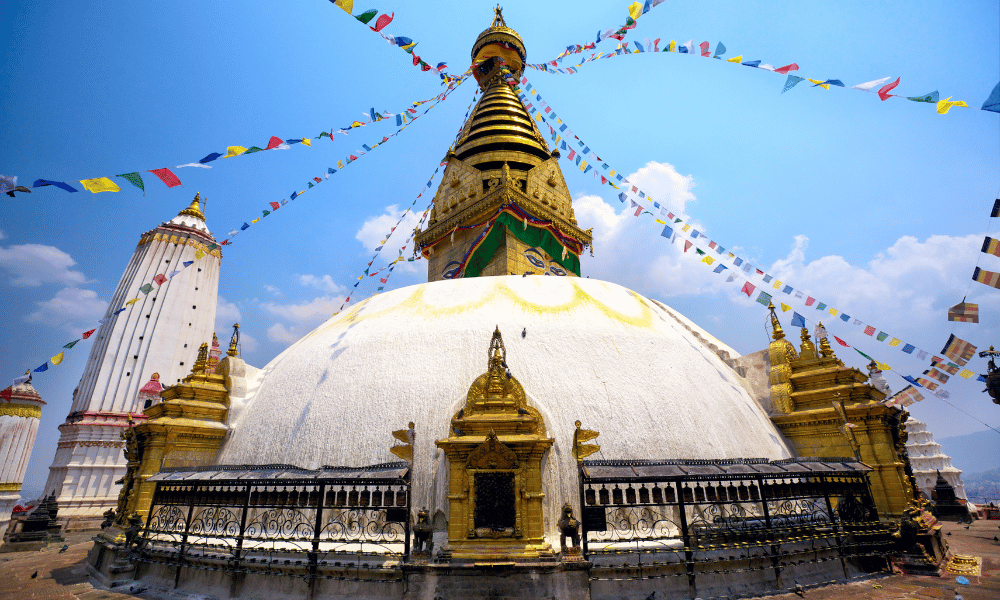
The entire Swayambhunath stupa acts as a physical manifestation of the Buddhist path to enlightenment. The whitewashed dome, representing the earthly world, supports a cubical structure, symbolising enlightenment. Each side of the cube displays the all seeing eyes of Buddha, radiating wisdom and compassion. There is no nose between the eyes, but rather a representation of the number one in the Nepali alphabet. It signifies that the only way to enlightenment is through the path of Buddhism. Above each pair of eyes is the third eye, enlightening the wisdom of looking from within. No ears are present because they say the Buddha is not interested in hearing praise for him. Above it are the Pancha Buddhas, namely Amitabha Buddha, Amoghashidhi Buddha, Akshyobha Buddha, Vairochana Buddha, and Ratnasambhava Buddha, representing the five cosmic elements ether, water, earth, fire, and air. Above it are thirteen tiered spires that crown the cube, each tier signifying a stage on the path to enlightenment. The spire is topped by a Gajur (Pinnacle), a structure with a crescent moon and sun, symbolising the balance between the material and spiritual realms.
This intricate architecture unfolds a rich tapestry of symbolism. The surrounding complex, with its smaller shrines and prayer wheels, further enriches the experience, making Swayambhunath stupa a discovery of spirituality and enlightenment.
Attractions Around the Stupa
Swayambhunath Stupa itself is a magnificent structure and a major attraction, but there are many other interesting things to see and do in the surrounding area. Some of the highlights you must not miss are:
Harati Temple
The Harati temple is a two story pagoda style structure gilded with gold. It is located on the northwestern side of the Swayambhunath stupa. The main entrance is flanked by two metal lions and Nepali flags. Above the entrance are three brass torana depicting the Five Dakini (protectress deities) of the Pancaraksa mandala. The two roofs are supported by artistic struts and gilded metal plates depicting 16 worshiping deities.
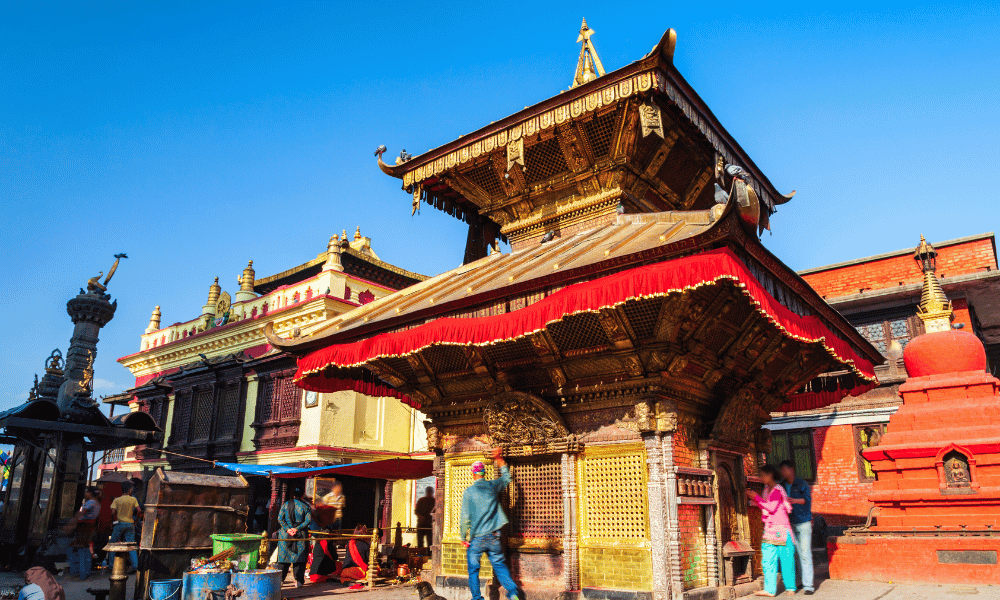
Harati is revered as the protector of children and is often depicted surrounded by many children. According to Buddhist legend, Harati was once a demon who stole and devoured children. The Buddha intervened and persuaded her to become a protector of children instead. Devotees offer prayers and pujas (ritual offerings) to Harati, seeking her protection for their children.
Anantapur and Pratappur Temples
The Anantapur Temple is on the southern side of Swayambhunath. It is named after King Pratap Malla's queen, Anantapriya. The temple is dedicated to the goddess Ajima, a form of the Hindu goddess Parvati. The Anantapur Temple is a three-story shikhara-style temple. The shikhara is the tall, pointed spire that is characteristic of Nepali architecture. The temple is made of brick and is decorated with intricate carvings of gods and goddesses.
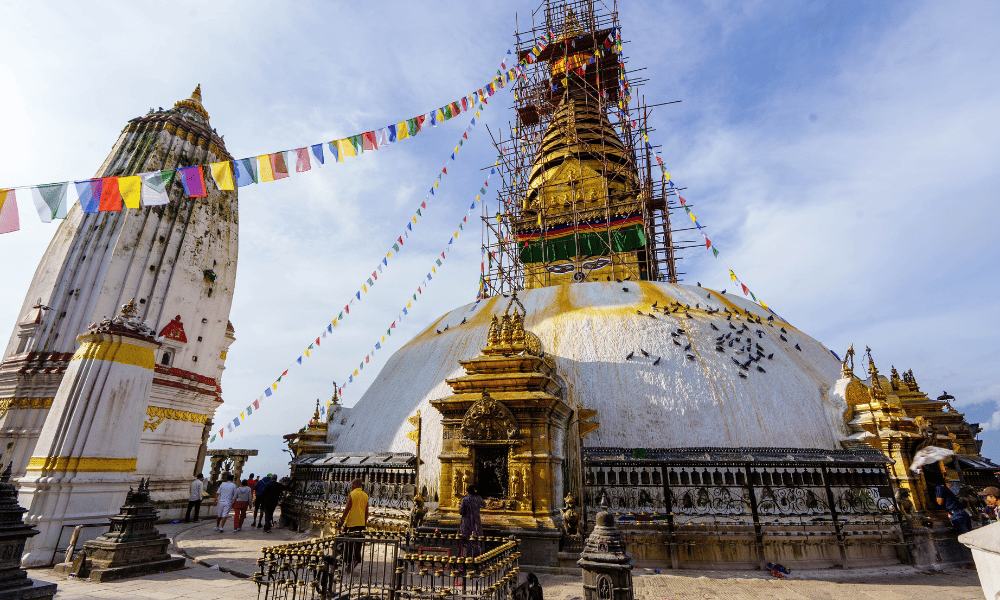
Similarly, the Pratappur Temple is on the northern side of Swayambhunath. It is named after King Pratap Malla himself. The temple is dedicated to the god Bhairava, a fierce form of the Hindu god Shiva. It is also a three-story shikhara-style temple similar in design to the Anantapur Temple, but it is slightly larger and is also decorated with intricate carvings of gods and goddesses.
Statue of Dipankar Buddha
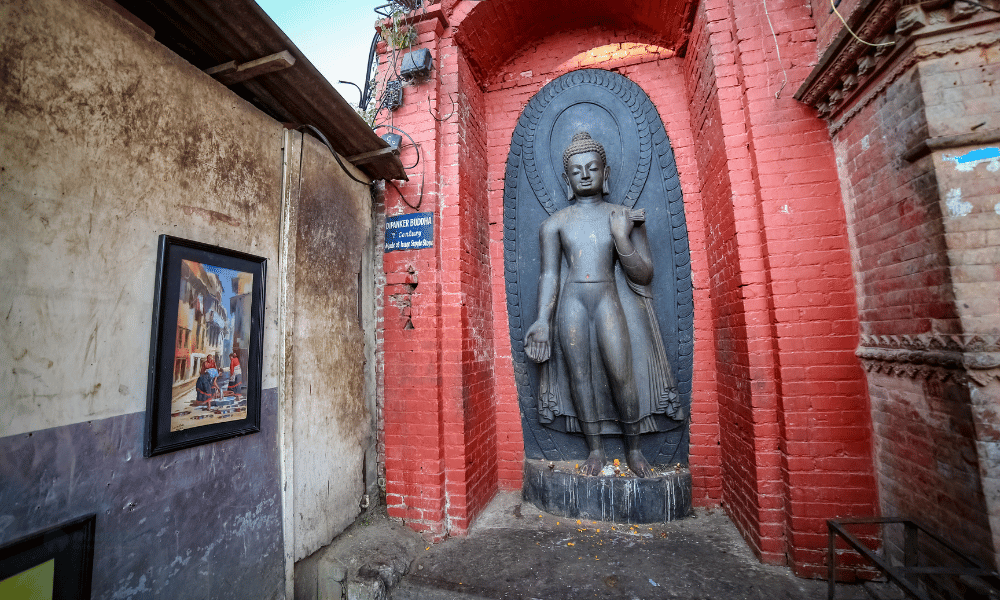
Behind the small statues at Swayambunath, the statue of Dipankar Buddha can be seen in the corner, which is a 7th century statue carved from a single piece of stone. Dipankar Buddha, who was believed to have lived on earth for about a thousand years, is regarded as the Buddha before Shakyamuni Buddha. The statue is about 10 feet tall and seems to be a Greek influenced monument. It is also a reminder of Buddha's teachings of compassion, wisdom, and enlightenment.
The Vajra (Lightening Bolt)
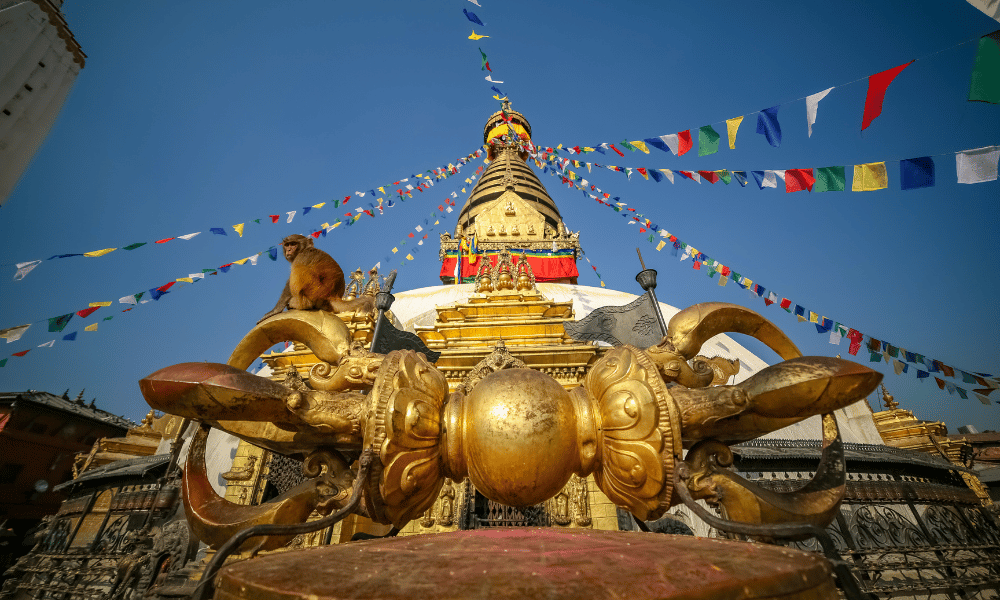
The vajra is the first thing to notice if one takes the main staircase to reach the stupa. The giant vajra, also referred to as a dorje, you see at Swayambhunath isn't exactly a lightning bolt, but a stylised depiction of the stone vajra set at the starting point of the site itself. It's a ritual instrument significant in Tibetan Buddhism and Hinduism. The word "vajra" itself comes from the Sanskrit word for "diamond" or "thunderbolt”. This vajra symbolises concepts like hardness, indestructibility, and power.
Dewa Dharma Monastery
The Dewa Dharma Monastery, also known as Dewa Dharma Mahavihar, is a historic Buddhist monastery situated on the western side of the Swayambhunath stupa. Following the Drupa Kagyu school of Tibetan Buddhism, the Deva Dharma Mahavihar emphasises meditation practices. While the exact date of construction is unknown, it is believed to be one of the oldest monasteries around the stupa, established by a Bhutanese lama around 1780. Despite facing fire damage in the 1800s and the 2015 earthquake, it's undergoing restoration. While smaller than other Swayambhunath monasteries, Deva Dharma Mahavihar holds significance for pilgrims visiting nearby shrines.
Amideva Buddha Park
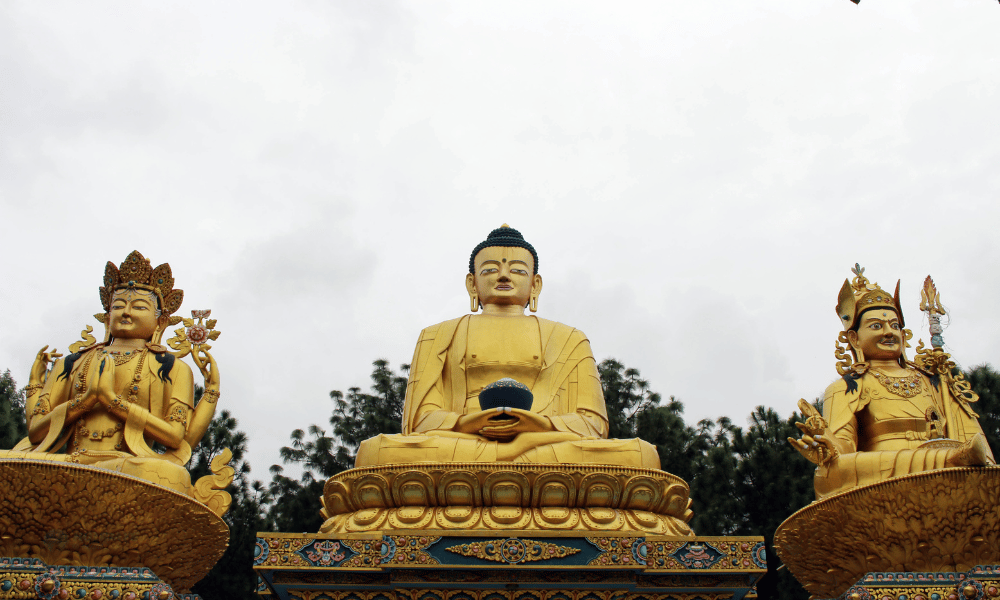
It's known for its three giant golden statues of Buddha and a small but beautiful garden. The central statue is a towering 67 feet tall and depicts Shakyamuni Buddha in his Amitabha (Amideva) form, associated with longevity. While the statue of Guru Rinpoche is on the right side, Chenrezig, also known as Avalokitesvara, stands on the left side. The park was built in 2003 and features a variety of Buddhist statues and decorations. Additionally, there are also artistic representations of holy mountains, notably Kailashnath, where Lord Shiva is believed to reside. A prominent golden Shiva lingam adjacent to Kailashnath is another captivating feature. Visitors can stroll around the park, enjoying the peaceful atmosphere and the interesting sculptures.
World Peace Pond
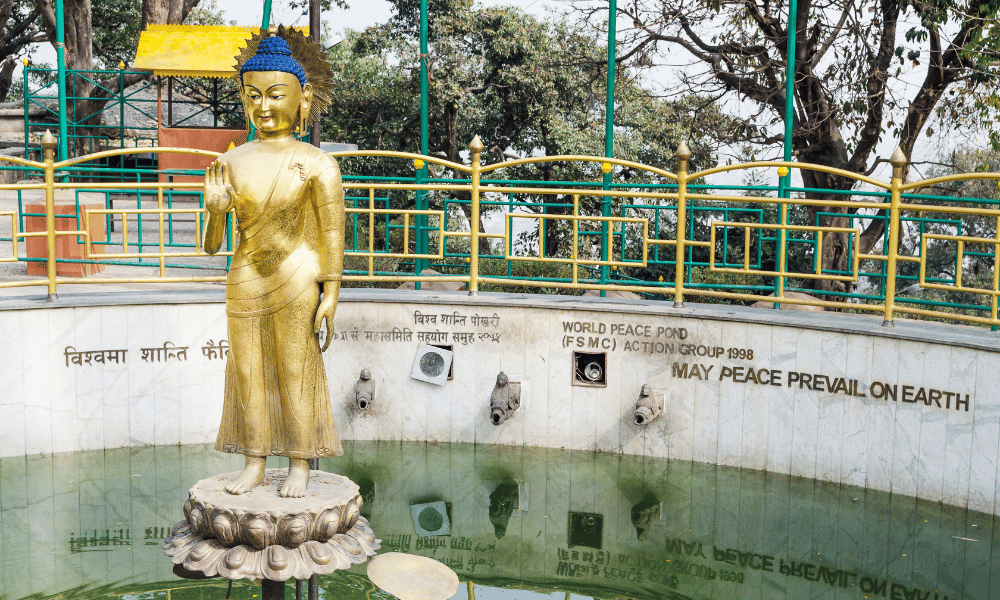
On the western side of Swayambhunath lies a hidden gem, the World Peace Pond. In the centre of the pond stands a gilded bronze statue of Siddhartha Gautama, the Buddha himself. A bowl rests near his feet, holding the key to a wish come true. Legend has it that if you can successfully toss a coin into the bowl, your wish will be granted. However, unlike many tourist destinations, coins aren't Nepal's everyday currency. Fear not, for enterprising vendors have set up shop nearby, ready to exchange your bills for a handful of wishes in waiting (coins). Moreover, the tranquil atmosphere and colourful prayer flags fluttering around the pond make it a perfect spot for quiet time.
Also Read: Boudhanath Stupa
Festivals and Rituals
Swaymbhunath not only invites pilgrims from around the world but also holds vivid festivals that underscore its significance in Buddhist and Hindu cultures. During these festivals, the air is filled with the aroma of incense and the sounds of ringing bells and monks chanting mantras. Among the celebrations, festivals such as Buddha Jayanti, Sonam Lhosar are seen as the most prominent. These festivals represent a great value in the Buddhist community.
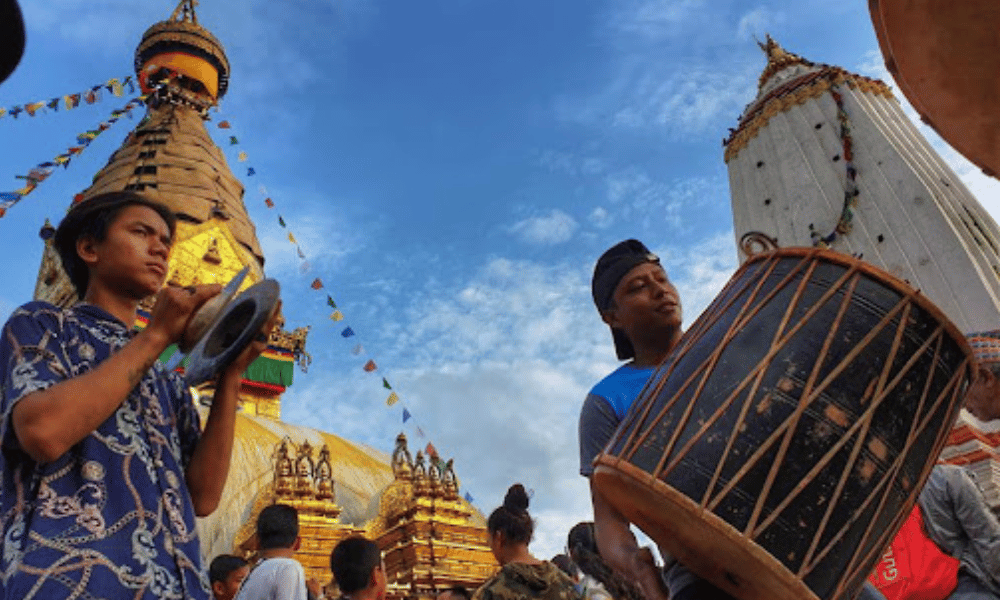
Buddha Jayanti
Buddha Jayanti, also known as Buddha Purnima, is the celebration of the birth of Siddhartha Gautama, the founder of Buddhism. While Buddha Jayanti falls on the full moon day in the Nepali month of Baishakh and May in the English calendar, the energy at Swayambhunath starts to build days before. Buddhists visit temples, participate in prayer sessions, and offer flowers, incense, and candles. Monks chant Buddhist scriptures. On Buddha Jayanti, the Swayambhunath grants free entry to the stupa complex, allowing everyone to participate in the festivities. Buddha Jayanti is not just a religious observance but a day that promotes peace, reflection, and the alleviation of suffering across the globe.
Gunla Parva
Gunla Parva is a month-long celebration observed by the Buddhist Newari community. This is a sacred period dedicated to accumulating religious merit (Dharma) and paying homage to Lord Buddha. It falls on the tenth month of the Nepal Sambat lunar calendar, which corresponds roughly to August in the Gregorian calendar. During Gunla Parva, devotees celebrate the glory of Lord Buddha and participate in various religious activities. Devotees make daily pilgrimages early in the morning to Buddhist temples, including Swaymabhunath Stupa. These pilgrimages are accompanied by the playing of Gunla Bajan, a special devotional song.
Sonam Lhosar
Sonam Lhosar marks the beginning of a new year based on the Tamang calendar, which follows a twelve year cycle similar to the Chinese zodiac and is celebrated by the Tamang and Hyolmo people of Nepal. It's a time for families to come together, enjoy delicious meals featuring various meats, rice dishes like Khapsey and Babar (similar to chapati) for the Hyolmo community, and sweet desserts. During Sonam Lhosar, the Swayambhunath stupa becomes a focal point for celebrations and rituals, drawing visitors from the Tamang community as well as other ethnic groups.
Beyond these grand festivals, Swayambhunath is a place of constant religious activity. Monks perform pujas daily, chanting mantras and offering prayers. Devotees from both religions light butter lamps, spin prayer wheels, and make offerings of flowers, seeking blessings and inner peace.
Also Read: Nepal Festival
Religious Coexistence
Swayambhunath stands as a testament to religious harmony in Nepal. Hindus and Buddhists have shared this sacred space for centuries. The stupa itself reflects this harmony, with its architecture blending Hindu and Buddhist symbolism. The presence of a Buddhist monastery such as Dewa Dharma Monastery alongside a Hindu temple such as Manjushree Temple dedicated to Saraswati further emphasises the acceptance of both traditions within the complex. Similarly, within the same premises, it houses a Buddhist stupa, Swayambhunath itself, and temples dedicated to Hindu god, Harati temple, Pratappur temple, and Annattapur temples.
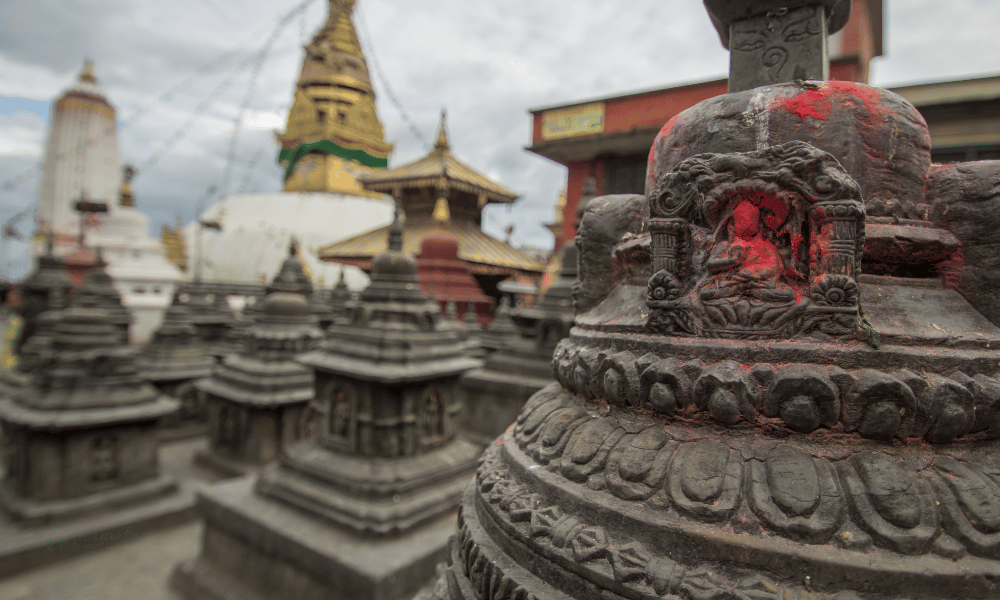
The practice of spinning prayer wheels is a common sight at Swayambhunath. Devotees of both faiths engage in similar rituals, like lighting lamps and circumambulating the stupa, creating a sense of unity in their devotion. Also, during festivals like Buddha Jayanti, Sonam Lhosar, and Gunla Parva, Swayambhu gathers a large number of crowds from different communities of both faiths. Participation in these festivals is not limited to a certain religion but is celebrated together in unity. This shared act signifies a common desire for peace, prosperity, and spiritual merit.
In a world often divided by religious differences, Swayambhunath offers a presence of hope. It demonstrates the possibility of peaceful coexistence, where diverse faiths can share a sacred space and celebrate their beliefs in a spirit of harmony.
Things To Remember Before Visiting
During your sightseeing in Kathmandu, Swayambhunath is one of the must see places for its cultural and religious significance. As you might be a new visitor, you will need a guide to visit the site. Here’s a guide for you to visit the site.
Opening Hours: Swayambhunath is open for 24 hours. Consider arriving early to witness the breathtaking sunrise over Kathmandu Valley, or visit in the late afternoon for a calmer atmosphere.
Entrance fees: Tourists must pay at the entrance to observe this world heritage site. Indian and SAARC nationals must pay NPR 50, and foreign nationals should pay NPR 200, including Chinese nationals.
Be mindful of Monkeys: While these creatures might seem friendly, avoid feeding them or making eye contact, as they can become aggressive.
Respectful Behaviour: Maintain respectful conduct throughout your visit. This is a sacred site for many, so keep noise levels down and avoid disrespectful behaviour.
Hire a guide: If you’re interested, hiring a cultural guide is a great way to learn more about Swayambhunath stupa and its significance in Nepali culture. Guides can be found at the base of the stairs leading up to the stupa or can be contacted through the travel companies.
Keeping in mind these tips, you can ensure a respectful and enriching visit to Swayambhunath Stupa.
Also Read: Buddhist Pilgrimage Sites in Nepal
How to Reach?
The Swayambhunath Temple, perched majestically about 5 km from the heart of Kathmandu and approximately 8 km from the Tribhuvan International Airport, beckons visitors with its spiritual aura and panoramic views. Here are several ways to embark on the journey to Swayambhu from Kathmandu:
Public transportation:
You can take a microbus or bus to Swaymbhunath, which is easily accessible from various bus stations around Kathmandu. It is the cheapest option, but it can be a little crowded at times of the day.
Taxi/bike:
A taxi is a more comfortable option, but it will be more expensive. You can also call for a bike, which is a bit cheaper.
Walking:
Swayambhunath is located just a few kilometres from Thamel, the tourist hub of Kathmandu. If you're feeling energetic, you can walk to the stupa. It's a pleasant walk that takes about 45 minutes and offers some great views of the city.
Package basis:
Many tour companies offer day tours of Kathmandu that include a stop at Swayambhunath. This can be a good option if you want to learn more about the stupa and its history. Some of the packages we provide are: Kathmandu Tour Package and the Kathmandu Luxury Tour Package.
Frequently Asked Questions (FAQs)
Here are some frequently asked questions about Swayambhunath Stupa:
Do I need to take a guide to Swayambhunath?
It might not be entirely necessary. However, if you want to learn deeply regarding the history and religious significance, a guide might be required. You can hire the guide directly from the base of the stupa or contact a travel agency to get one for you.
Why is it called the Monkey Temple?
Swayambhunath stupa is also named the "Monkey Temple" because of the large population of monkeys that call the area around the stupa home. These monkeys have been there for generations and are considered holy by some Hindus and Tibetan Buddhists. One story also claims that the monkeys originated from lice in the hair of Manjushree, the bodhisattva of wisdom, who was said to have raised the hill where the stupa stands.
What architectural style is Swaymbhunath?
Swayambhunath is a religious complex, and the architectural style is a blend of Buddhist and Hindu elements. The architectural styles found at the site are Swayambhunath Stupa in dome style, Prattapur Temple and Annatapur Temple in Shikhara style, and Harati Temple in pagoda style. Hence, different architectural shrines and monuments make up a single Swayambhunath premises.

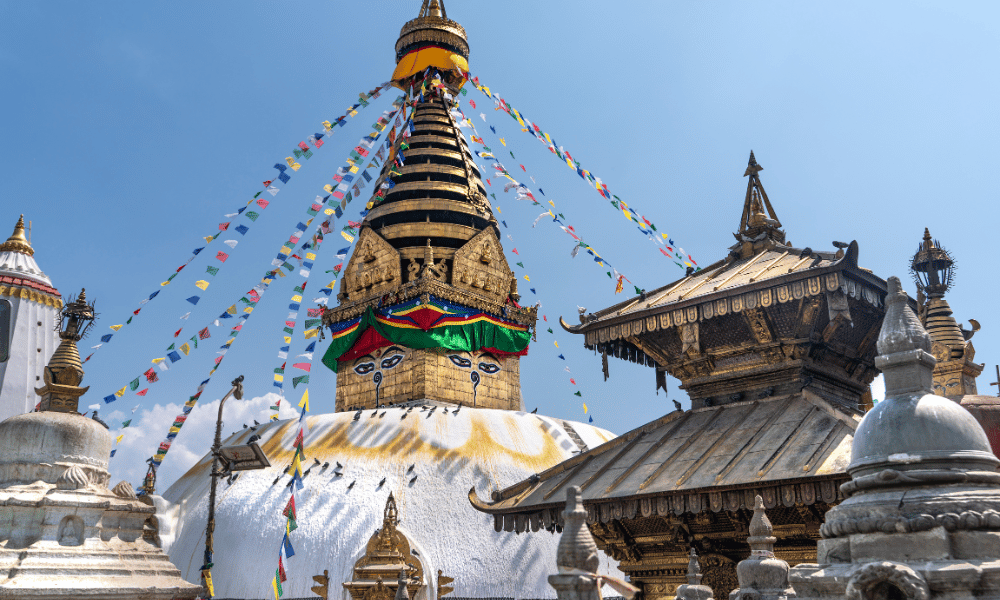
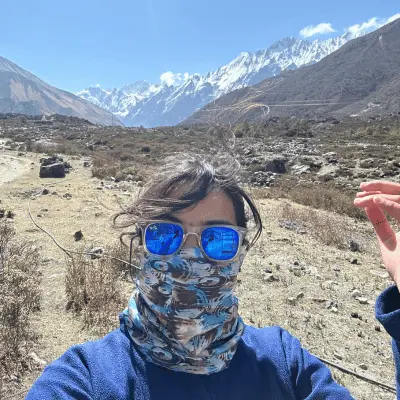 Mandira Itani
Mandira Itani